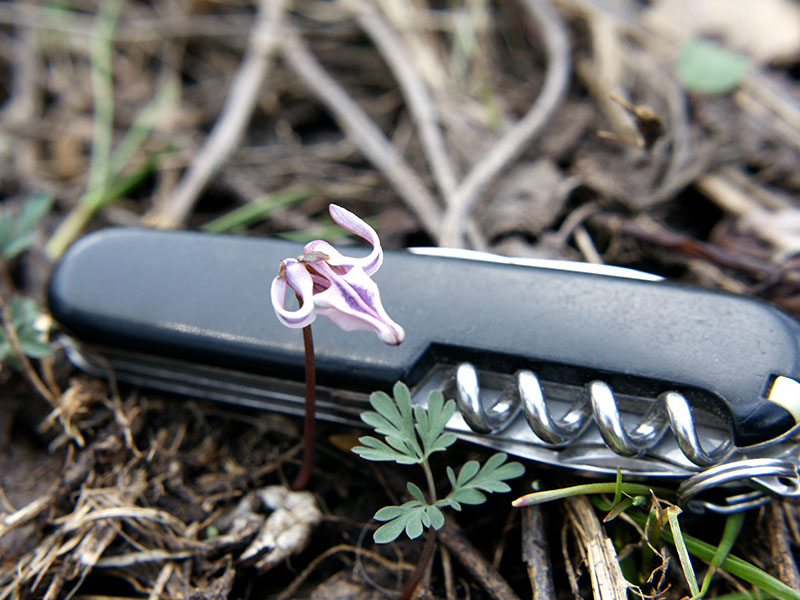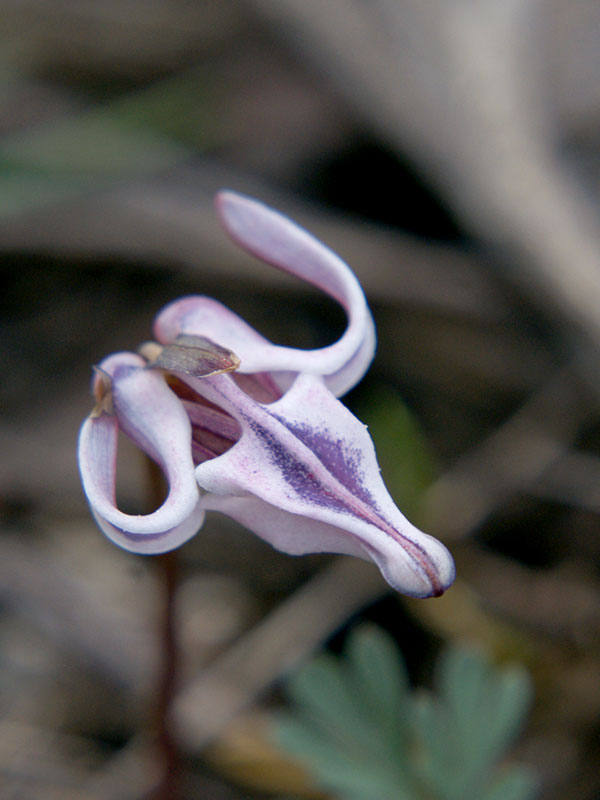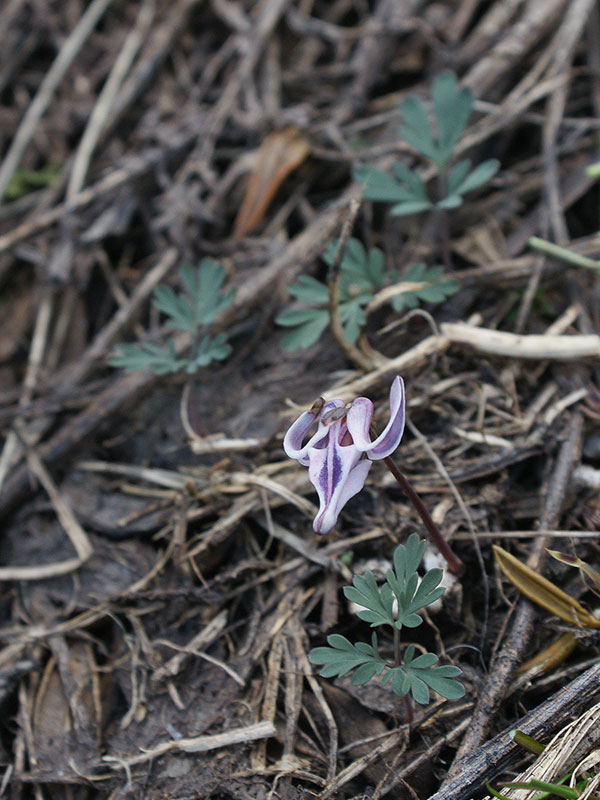Dicentra uniflora / steer’s head
- looks like a very small, peach-colored long-horned steer’s skull
- leaves are 3-fold compound; leaflets deeply divided
- leaves and flowers appear to be separate plants
- on rocky, vernally-moist slopes right at snowmelt
- considered hard to find but not rare
Also known as: longhorn steer’s head, one-flowered Dicentra
If you can mistake this plant for anything else, perhaps you should be doing something other than looking for wildflowers.
At the same time, however, if you see this at all, you are doing well. Russ Cary, on his delightful Yosemite Hikes site, describes it aptly as “both surprisingly common and maddeningly hard to find – the neutrino of wildflowers”. In addition, when you first go looking, it takes a while after you see the flowers before they actually become visible; they are simply too small (1/2 inch long), they look like the surrounding rocks and fallen leaves, and they are there for only a very short period after snowmelt.
Appropriately, a group of this plant growing in one area, i.e anywhere you can see several at the same time, is called a “herd”. I’ve seen photos; they do occur, but I haven’t actually seen one.
Given all that introduction… Dicentra uniflora is a short (less than 4 inches) herbaceous perennial growing from a tuber. It is native to vernally moist, gravelly soils on rocks in mountains. You will find it early in the season as the snow recedes. If you find it. It is a tiny plant and the leaves and flowers grow on separate stems, relatively far apart from each other (keeping in mind that all this is in miniature). The tuber from which they grow is well beneath the soil surface.
Steer’s head leaves are long stalked, and 3-times compound. The leaflets are rounded and deeply divided. If you have the garden variety bleeding heart in your garden, then you will notice the resemblance. Somehow, despite the fact that they are just green, the leaves stand out more than the flower. Find the leaves and you will hopefully find the flower. But don’t count on it… many plants have just the leaves, even in the flowering season. (There is an explanation of this later on).
The flowers themselves are held singly at the top of a stem that reaches only slightly above leaf height. The flowers are pink, or white or peach (depending on who taught you your colors or what kind of peaches you eat). Going by the old anglo-centered Crayola standards, they are sometimes called “flesh color”. The petals are tinged with light brown or purple-ish bits, but you don’t need to know that to identify the plant. The flowers are bilaterally symmetric, just like a face, and clearly resemble a steer’s skull with horns. This is due to the fact that the two outer petals are bent back while the two inner ones are fused at the tip forming the “snout”. The gaps between the petals look like the eye-sockets of the skull.
So, is this rare or common? Different sites say different things. Basically, the answer depends on how fast you get up a hill after the snow melts and how good you are at finding very small rock-colored things in a pile of rocks.
Interesting bits – With weird plants like this, especially teeny spring ephemerals on mountain soils, I never cease to be amazed that they can exist at all. However, this spring there was an article on the biology of steer’s head published in the ecology journal, Madroño that explains some of this.
As expected, the authors noted that plant emergence in the spring was closely linked to snowmelt. Beyond that, the time between flowering to senescence was a mere six to seven weeks. The time it takes to go from flowering to seed set is even shorter… less than 3 weeks. Still, the plants are efficient at producing seeds (ca. 85% success) and prolific (45-90 seeds per plant).
By planting out seeds in the field, the authors showed that germination can occur below the snow in winter; the very very small seedlings emerge from the ground in the spring. Quickly, they produce a small storage “bulblet” before disappearing with the summer drought.
That, of course, is not enough to support a flower the next year. Rather, year 2 sees a new bulblet and perhaps a teeny tiny tuber, but only one leaf. Indeed, it may take this little, fragile plant up to 10 years to reach a size capable of supporting a flower.
And when it does get there, it has a couple of tubers less than an inch long and 9-ish bulblets about 1/8 of an inch long. The tubers are buried deeply – with their tops from about 1 to 4 inches below the surface of the rocky, sandy soils where they live.
Meanwhile, while they are sitting around, the bulblet are capable of asexual reproduction – cloning – but certainly won’t take over the world.
May the force be with you and may you sometime be lucky enough to find this flower.
| Color | |
|---|---|
| Family | |
| Blossom size | |
| Inflorescence size | |
| Inflorescence type | |
| When? | |
| Where? |



